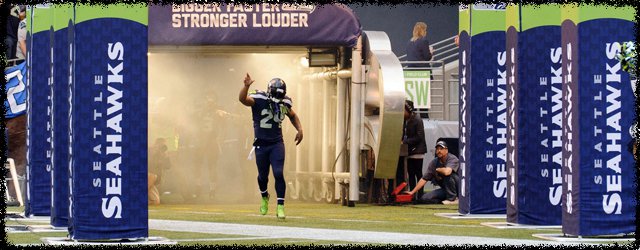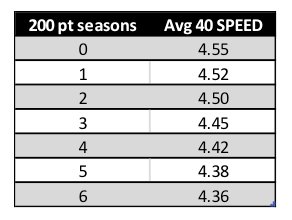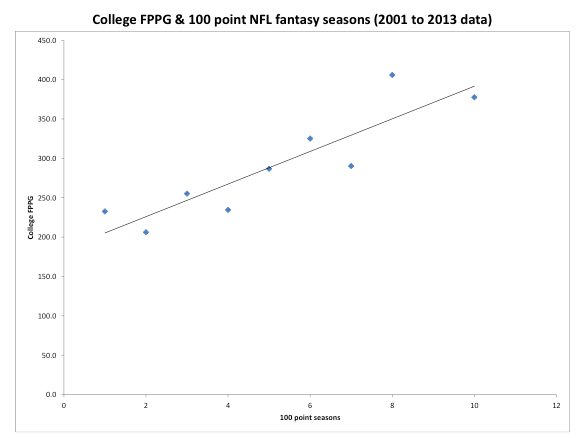Dynasty Deep Dive: Running Back Benchmarks

We have some expectations of the average running back, but how do we avoid risk and when do we use common sense? By introducing some benchmarks and creating some high level rules, we can then determine how to make smart dynasty choices.
[am4show have=’p2;p3;p4;p5;p6;’ guest_error=’sub_message’ user_error=’sub_message’ ]
Rule 1 – 40 time is the most important combine test for long-term running back success
The concept of “top-end speed” or “second gear” is thrown around come NFL draft day and I’m telling you it should be used on your fantasy draft day, too. It is the highest correlated combine test to actual fantasy (oxymoron?) performance and can actually help you understand the value of a running back in different formats.
First, let’s look at overall fantasy performance and how it measures up against 40 yard dash times. The chart below is comparing the average speed of a running back relative to the number of 200-point seasons, our starting point threshold. There is a clear relationship between the sustained success of a starting running back and his speed. This holds true when comparing average fantasy output against 40 times as well so it is correlated beyond just the starting running back threshold.

Going a step further, by dissecting different stats for running backs, there are a few key correlations that stick out. A faster running back is catching more passes, gaining more total yards and scoring slightly more touchdowns than a slower running back. However, there is less correlation in rushing yardage and 100-yard rushing games, which seems to be an indication of a lower useage rate or the lack of “bellcow” status. This tells you that in a league that rewards less for receptions or reception yardage, a faster back is less valuable. But in leagues that are PPR or have equal to higher rewards for receiving vs. rushing yardage; the fast back is the way to go.
Rule 2 – Size has limited impact on fantasy scoring
The concern many fantasy owners have when drafting running backs, particularly rookie backs, is if they have the size to translate to the professional game. In today’s game of multiple running backs and specialized roles, there isn’t the same emphasis on finding the one prototypical back. Height and weight (and calculated BMI) have minimal impact on overall scoring, but can shift slightly depending on your scoring format. A strong negative correlation does exist between running back height and receiving ability, which is important when looking at scoring settings around receptions and receiving yards. The exceptions to this tend to be quicker running backs (like Adrian Peterson) or running backs who showed their receiving ability in college (like Matt Forte, but more on this later).
Rule 3 – The NFL Draft shows the line to avoid when pursuing running backs
Just like quarterbacks, running back talent is evaluated well for fantasy purposes by NFL scouting departments. Even with the emphasis on avoiding running backs in the first round, there is a clear line that exists where the talent (and production) falls off. Looking at the chart below, the first three rounds show the average running back is contributing above the threshold we established earlier for a contributing back. The fourth round becomes much blurrier as the production drops significantly but in larger leagues, these are likely viable players to fill a roster spot. Past the fourth however, and we start to see opportunity and talent coincide where there is little difference between your average fifth and seventh round running back.

When looking at the most recent rookie class, it does make sense. There are a few fourth round picks who could exceed the average in Andre Williams and Devonta Freeman, but it also confirms a wariness you may have in other fourth round running backs like Ka’Deem Carey or De’Anthony Thomas. Furthermore, a supposed sleeper like Lache Seastrunk looks like an extreme gamble as a sixth rounder despite his positive scoring in some of our other criterion.
Rule 4 – College success is an indicator of professional success
Quarterbacks had a similar rule with specific statistics proving to be significantly correlated with fantasy scoring. In running backs, we have several similar findings. For one, college fantasy points per game are very strongly correlated with the rate of 100 point NFL fantasy seasons, which you can see below. The greater the success of a running back in their last year of college, the more likely that they have a lasting impact on your fantasy team.

Unfortunately, most individual statistics in college do not translate in the NFL. For example, running backs who accumulated high yardage totals in college were not necessarily able to do the same as a professional. This is likely due to college football teams relying on one running back throughout the season as opposed to the more specialized nature of the NFL. The one exception, as alluded to in rule two, is receptions and receiving yardage. By and large, a running back who was a successful receiver in college has been able to duplicate that as a professional. As you can see below, the trend tends to have a positive variance as a running back was a more prolific receiver in college, indicating opportunity for upside. In PPR leagues or deeper leagues where specialized running backs are used to fill out a roster, this is valuable information to utilize.

Stay tuned for the final part of this series where we utilize the learnings of part one and the rules in part two to evaluate rookies, new starters and other young running backs.
[/am4show]
- Bowl Game Previews: CFB Playoff Semifinals - December 28, 2018
- The Narrative Fallacy and How it Compels Us - May 13, 2017
- 2017 NFL Draft – College Wide Receiver AIR - April 27, 2017

































































